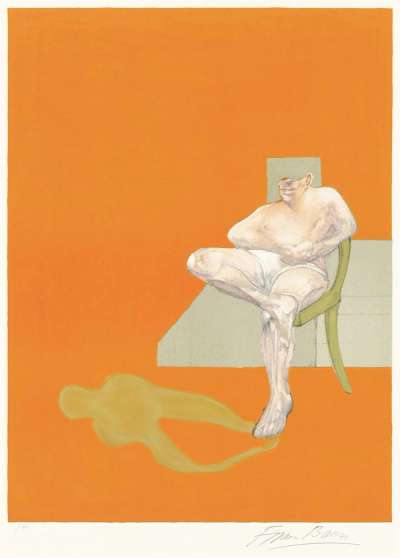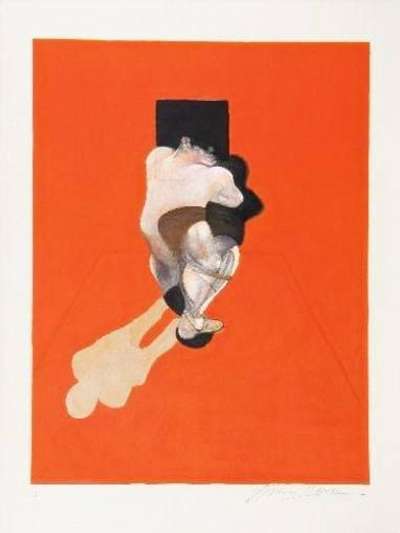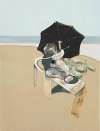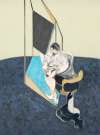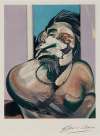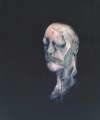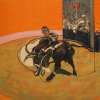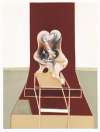Triptych
1983
These prints showcase a 1983 Francis Bacon painting titled Triptych. On violently orange backgrounds, he depicts a semi-human nude. Through the juxtaposition of fore and background, Bacon emphasizes the fleshiness of the body, haunted by death in the wake of the recent suicide of his lover and muse George Dyer.
Francis Bacon Triptych 1983 For sale
Triptych 1983 Value (5 Years)
With £23124 in the past 12 months, Francis Bacon's Triptych 1983 series is one of the most actively traded in the market. Prices have varied significantly – from £2948 to £39912 – driven by fluctuations in factors like condition, provenance, and market timing. Over the past 12 months, the average selling price was £11562, with an average annual growth rate of 1.93% across the series.
Triptych 1983 Market value
Auction Results
| Artwork | Auction Date | Auction House | Return to Seller | Hammer Price | Buyer Paid |
|---|---|---|---|---|---|
 Triptych 1983 (right panel) Francis Bacon Signed Print | 15 Sept 2023 | Ketterer Kunst Hamburg | £3,400 | £4,000 | £6,000 |
 Triptych 1983 (left panel) Francis Bacon Signed Print | 20 Jul 2022 | Ansorena | £5,100 | £6,000 | £6,000 |
 Triptych 1983 (centre panel) Francis Bacon Signed Print | 14 Mar 2022 | Millon & Associes | £4,250 | £5,000 | £5,000 |
Sell Your Art
with Us
with Us
Join Our Network of Collectors. Buy, Sell and Track Demand
Meaning & Analysis
As its name suggests, this collection showcases a 1983 triptych by Irish-born artist Francis Bacon entitled Triptych (1983). Born in Dublin in 1909, Bacon went on to become extremely well known as a figurative painter; famed for spending long periods of his career focusing on distinct themes, Bacon painted subjects as diverse as popes, crucifixions, and bullfights, before moving towards portraiture in his later years. As in this collection, many of Bacon’s works were produced as triptychs: three-part paintings designed to be exhibited alongside each other. Three lithograph prints, each issued in an edition of 180, make up the substance of this collection and are copies of the original paintings. Titled Triptych 1983 (centre panel) , Triptych 1983 (left panel), and Triptych 1983 (right panel), they are each standout examples of Bacon’s unique visual style, but are noticeable for their slight deviation from the raw, visceral and unnerving depiction of human – and animal – forms by which his earlier paintings are often characterised.
In each panel, a deep orange background provides a sense of stark contrast with the light, fleshy tones of a semi-human figure, jutting out from this mostly uniform block of thickly applied paint. In the left panel, a figure sits on an abstracted chair, their leg offering closer resemblance to that of a dead animal than that of a human. Referencing the fleshy pre-occupations of Bacon’s Figure With Meat (1954), the faceless form is joined by their fluid, ghost-like shadow and is framed by an unpainted section that recalls a stage of plinth. In the centre panel, humanity appears less present. The piece is haunted by a biomorphic, fantom-like creature that looks back towards the viewer. This figure is positioned as though walking towards a black, rectangular void.
A recurrent motif of Bacon’s paintings during this period, such as The Metropolitan Triptych (centre panel) (1975), this area of dark colour goes hand-in-hand with a series of smoke-like lines to conjure a sense of foreshadowing and death. In contrast with the first two panels of Triptych, the right is perhaps the most human element of the work. It features a defiantly human, male figure sitting proudly in a one-legged chair; behind the figure is another of Bacon’s trademark framing devices. Following the death of Bacon’s onetime lover, muse, and friend George Dyer in 1971, death began to permeate the artist’s work in a pointed and disturbing manner largely unseen in his earlier paintings. The Triptych 1983 collection is no different: thematically similar to the artist’s so-called ‘Black Triptychs’, particularly the painting Triptych August 1972, Triptych (1983) can be read as a depiction of Dyer prior to his tragic death in a Paris hotel room.

